Physics - Rolling Motion | 11th Physics : UNIT 5 : Motion of System of Particles and Rigid Bodies
Chapter: 11th Physics : UNIT 5 : Motion of System of Particles and Rigid Bodies
Rolling Motion
ROLLING
MOTION
The rolling motion is the most
commonly observed motion in daily life. The motion of wheel is an example of
rolling motion. Round objects like ring, disc, sphere etc. are most suitable
for rolling .
Let us study the rolling of a disc
on a horizontal surface. Consider a point P on the edge of the disc. While
rolling, the point undergoes translational motion along with its center of mass
and rotational motion with respect to its center of mass.
Combination of Translation and Rotation
We will now see how these
translational and rotational motions are related in rolling. If the radius of
the rolling object is R, in one full rotation, the center of mass is displaced
by 2πR (its circumference). One would agree that not only the
center of mass, but all the points on the disc are displaced by the same 2πR after one full rotation. The only difference is that the
center of mass takes a straight path; but, all the other points undergo a path
which has a combination of the translational and rotational motion. Especially
the point on the edge undergoes a path of a cycloid as shown in the Figure
5.31.
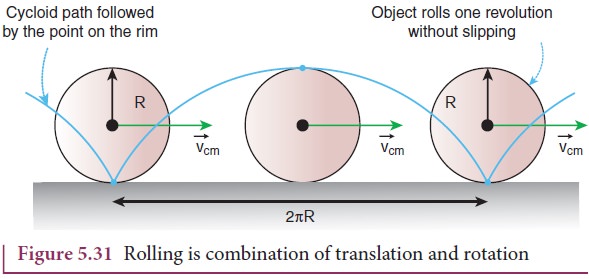
As the center of mass takes only a
straight line path, its velocity vCM is only translational velocity
vTRANS (vCM = vTRANS). All the other
points have two velocities. One is the translational velocity vTRANS,
(which is also the velocity of center of mass) and the other is the rotational
velocity vROT (vROT = rω). Here, r is the distance of the
point from the center of mass and ω is the angular velocity. The
rotational velocity vROT is perpendicular to the instantaneous
position vector from the center of mass as shown in Figure 5.32(a) . The resultant
of these two velocities is v. This resultant velocity v is perpendicular to the
position vector from the point of contact of the rolling object
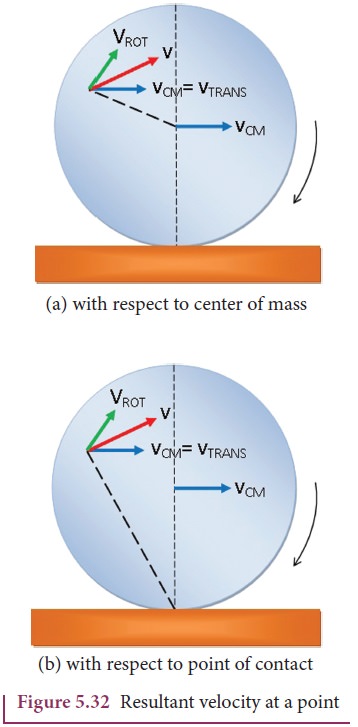
We shall now give importance to the
point of contact. In pure rolling, the point of the rolling object which comes
in contact with the surface is at momentary rest. This is the case with every
point that is on the edge of the rolling object. As the rolling proceeds, all
the points on the edge, one by one come in contact with the surface; remain at
momentary rest at the time of contact and then take the path of the cycloid as
already mentioned.
Hence, we can consider the pure
rolling in two different ways.
i. The combination of translational
motion and rotational motion about the center of mass.
Or
ii. The momentary rotational motion
about the point of contact.
As
the point of contact is at momentary rest in pure rolling, its resultant
velocity v is zero (v = 0). For example, in Figure 5.33, at
the point of contact, vTRANS is forward (to right) and vROT
is backwards (to the left).
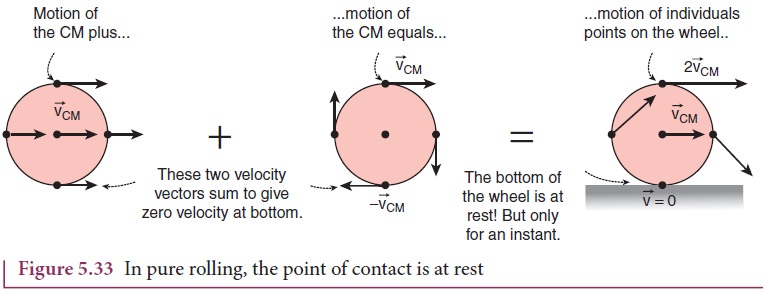
That implies that, v TRANS
and vROT are equal in magnitude and opposite in direction (v = vTRANS- vROT = 0). Hence, we conclude that in pure rolling, for all the
points on the edge, the magnitudes of vTRANS and vROT are
equal (vTRANS= vROT). As vTRANS
= vCM and vROT = Rω, in pure rolling we have,
vCM = Rω
(5.55)

We should remember the special
feature of the equation 5.55. In rotational motion, as per the relation v = rω, the center point will not have any
velocity as r is zero. But in rolling motion, it suggests that the center point
has a velocity vCM given by equation 5.55.
For the topmost point, the two
velocities vTRANS and vROT are equal in magnitude and in
the same direction (to the right). Thus, the resultant velocity v is the sum of
these two velocities, v = vTRANS + v ROT. In other form, v = 2 vCM as shown in Figure 5.34.
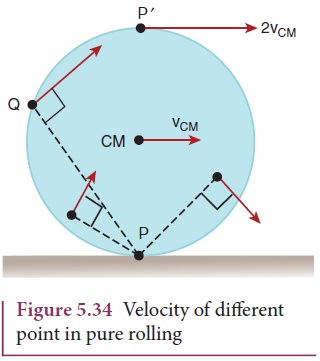
Slipping and Sliding
When the round object moves, it always tends to roll on any surface which has a coefficient of friction any value greater than zero (µ > 0). The friction that enabling the rolling motion is called rolling friction. In pure rolling, there is no relative motion of the point of contact with the surface. When the rolling object speeds up or slows down, it must accelerate or decelerate respectively. If this suddenly happens it makes the rolling object to slip or slide.
Sliding
Sliding is
the case when vCM
> Rω (or vTRANS > vROT). The translation
is more than the rotation. This kind of motion happens when sudden break is
applied in a moving vehicles, or when the vehicle enters into a slippery road.
In this case, the point of contact has more of vTRANS than vROT.
Hence, it has a resultant velocity v in the forward direction as shown in
Figure 5.35. The kinetic frictional force (fk) opposes the relative
motion. Hence, it acts in the opposite direction of the relative velocity. This
frictional force reduces the translational velocity and increases the
rotational velocity till they become equal and the object sets on pure rolling.
Sliding is also referred as forward slipping.
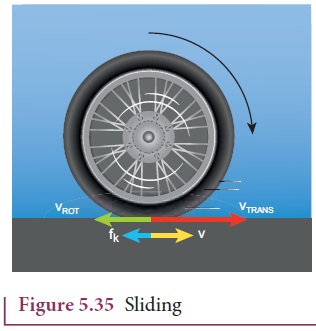
Slipping
Slipping is
the case when vCM
< Rω (or vTRANS < vROT). The rotation is
more than the translation. This kind of motion happens when we suddenly start
the vehicle from rest or the vehicle is stuck in mud. In this case, the point
of contact has more of vROT than vTRANS. It has a
resultant velocity v in the backward direction as shown in Figure 5.36. The
kinetic frictional force (fk) opposes the relative motion. Hence it
acts in the opposite direction of the relative velocity. This frictional force
reduces the rotational velocity and increases the translational velocity till
they become equal and the object sets pure rolling. Slipping is sometimes
empahasised as backward slipping.
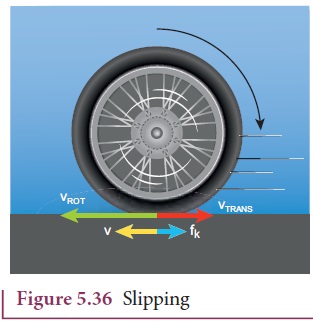
Kinetic Energy in Pure Rolling
As pure is the combination of
translational and rotational motion, we can write the total kinetic energy (KE)
as the sum of kinetic energy due to translational motion (KETRANS)
and kinetic energy due to rotational motion (KEROT).

If the mass of the rolling object is
M, the velocity of center of mass is vCM, its moment of inertia
about center of mass is ICM and angular velocity is ω, then

With center of mass as reference:
The moment of inertia (ICM)
of a rolling object about the center of mass is,
I CM = MK2 and vCM = Rω. Here, K is radius of gyration.

With point of contact as reference:
We can also arrive at the same
expression by taking the momentary rotation happening with respect to the point
of contact (another approach to rolling). If we take the point of contact as O,
then,

Here, Io is the moment of
inertia of the object about the point of contact. By parallel axis theorem, I o = I CM + MR2. Further we can
write, Io = MK2 + MR2. With vCM
= Rω or ω = VCM/R.
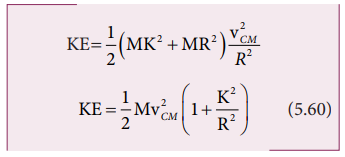
As the two equations 5.59 and 5.60
are the same, it is once again confirmed that the pure rolling problems could
be solved by considering the motion as any one of the following two cases.
i. The combination of translational
motion and rotational motion about the center of mass. (or)
ii. The momentary rotational motion about the point of contact.
Rolling on Inclined Plane
Let us assume a round object of mass
m and radius R is rolling down an inclined plane without slipping as shown in
Figure 5.37. There are two forces acting on the object along the inclined
plane. One is the component of gravitational force (mg sinθ) and the other is the static frictional force (f). The other
component of gravitation force (mg cosθ) is
cancelled by the normal force (N) exerted by the plane. As the motion is
happening along the incline, we shall write the equation for motion from the
free body diagram (FBP) of the
object.
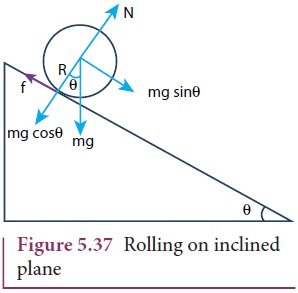
For translational motion, mg sinθ is the supporting force and f is the opposing force,
mg sinθ - f = ma (5.61)

For rotational motion, let us take the torque
with respect to the center of the object. Then mg sinθ cannot cause torque as it passes through it but the
frictional force f can set torque of Rf.
Rf = Iα

By using the relation, a = r α, and moment of inertia I = mK2, we get,

Now equation (5.59) becomes,
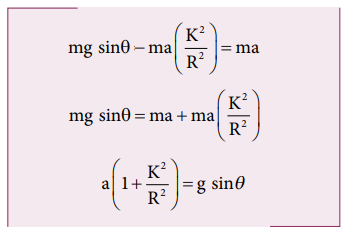
After rewriting it for acceleration,
we get,

We can also find the expression for
final velocity of the rolling object by using third equation of motion for the
inclined plane. v 2 = u2 + 2as. If the body starts rolling from rest, u = 0. When h is the vertical height of the incline, the length
of the incline s is, s = h/sinθ
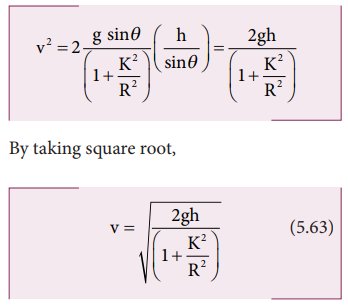
The time taken for rolling down the
incline could also be written from first equation of motion as, v = u + at. For the object which starts
rolling from rest, u = 0. Then,
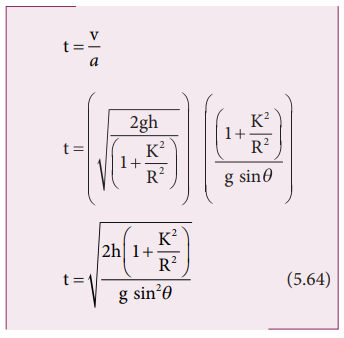
The equation suggests that for a
given incline, the object with the least value of radius of gyration K will
reach the bottom of the incline first.
Solved Example Problems for Slipping and Sliding(Rolling Motion)
Example 5.21
A rolling wheel has velocity of its center of mass as 5 m s-1. If its radius is 1.5 m and angular velocity is 3 rad s-1, then check whether it is in pure rolling or not.
Solution
Translational velocity (vTRANS) or velocity of center of mass, vCM = 5 m s-1
The radius is, R = 1.5 m and the angular velocity is, ω = 3 rad s-1
Rotational velocity, vROT = Rω

As vCM > Rω (or) vTRANS > Rω, It is not in pure rolling, but sliding.
Solved Example Problems for Kinetic Energy in Pure Rolling(Rolling Motion)
Example 5.22
A solid sphere is undergoing pure rolling. What is the ratio of its translational kinetic energy to rotational kinetic energy?
Solution
The expression for total kinetic energy in pure rolling is,

For any object the total kinetic energy as per equation 5.58 and 5.59 is,
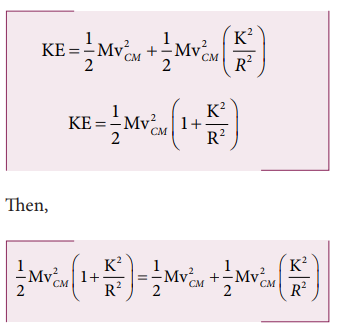
The above equation suggests that in pure rolling the ratio of total kinetic energy, translational kinetic energy and rotational kinetic energy is given as,
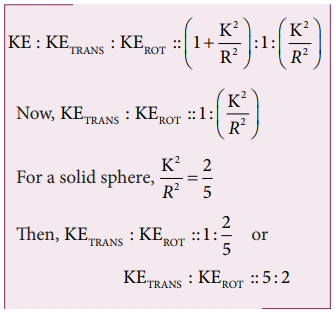
Solved Example Problems for Rolling on Inclined Plane(Rolling Motion)
Example 5.23
Four round objects namely a ring, a disc, a hollow sphere and a solid sphere with same radius R start to roll down an incline at the same time. Find out which object will reach the bottom first.
Solution
For all the four objects namely the ring, disc, hollow sphere and solid sphere, the radii of gyration K are R,
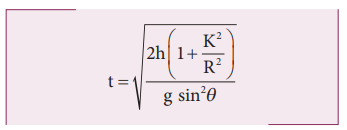
The one with least value of radius of gyration K will take the shortest time to reach the bottom of the inclined plane. The order of objects reaching the bottom is first, solid sphere; second, disc; third, hollow sphere and last, ring.
Related Topics